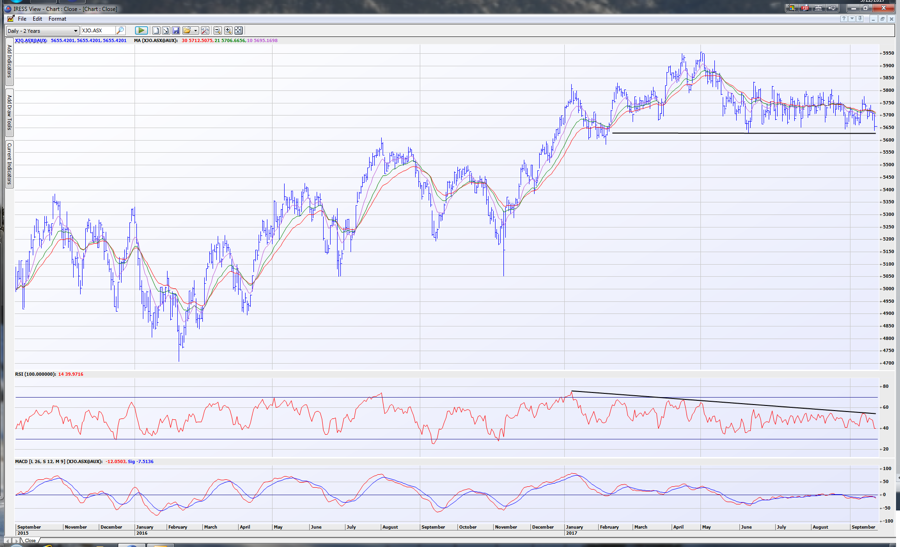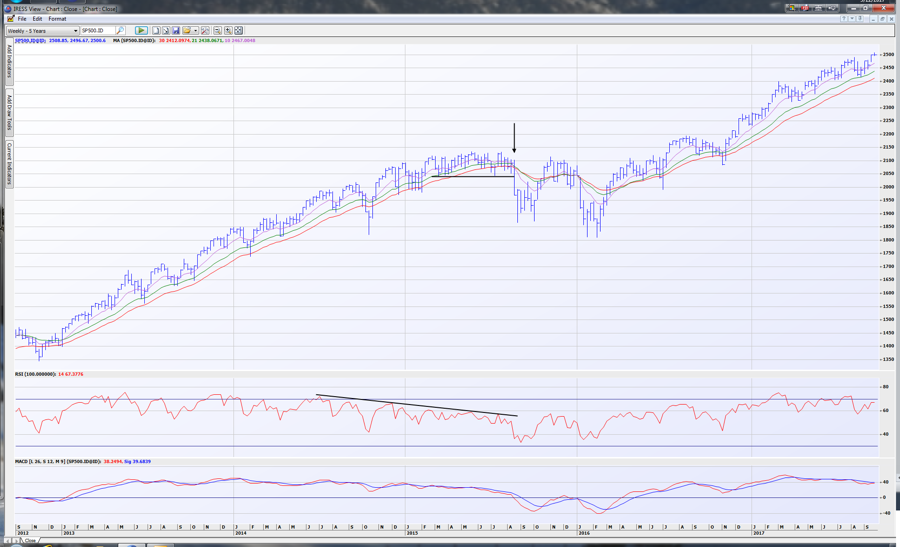Currently my market positions are 90% short in keeping with the bearish view I have expressed here on equity markets, particularly the Australian market. The local market continues to look increasingly vulnerable for a serious decline as the “excesses” of the past two decades begin to be a burden on consumers.
Banks and retail have continued to fall in value and most recently I have been shorting the interest rate sensitive stocks (property trusts and infrastructure) as bond yields have spiked. The Federal Reserve’s announcement that they will begin unwinding their $4 trillion dollar balance sheet will continue to put upward pressure on interest rates acting as a major headwind for these two sectors.
Moreover, I always know the ASX 200 is in trouble when US indices can make new highs, but the local market cannot follow suit. This is always dangerous and with volatility remaining at near record levels, investors are equally complacent about the downside risks. The chart below of the ASX 200 shows the clear top formation that is still in the process of being completed across 5630. Thursday’s close was the lowest close since the beginning of the year and to me is a sign that an imminent drop is in the offing. I wrote two months ago in this column for investors to be very cautious and I hope that you all have taken some action to at least be prepared in the event the market does slice through the bottom side.
I am always encouraged when indicators also display signals that support the price action of the physical index and it is visible as well that the RSI indicator has its own trendline resistance that stretches back to the start of the year. Many of the individual banking stocks have a similar set up as well. This trendline has marked each of the rally peaks throughout the year and as each failure gets lower and lower, we are closer to a capitulation. Together with a MACD (bottom indicator) that has failed to surpass the zero line and momentum/risk is building to the downside.

Regular readers will know that I often compare market periods to history as a guide of what to expect. I don’t do this very often, but when I do find markets repeating themselves it is a very powerful tool that regularly, in our application at least, provides a framework for how price action might unfold. The current tight range on the ASX 200 of 150 points has lasted for 90 trading days and reminds me very much of the tight and persistent range the S&P 500 was operating in during 2015.
During that period the S&P 500 was effectively caught in a tight range for approximately 26 weeks before suddenly dropping through the bottom-end of that range and collapsing 11% in the space of just 9 days. There was little time to react once prices fell away. Like the ASX 200, indicators were also highlighting the negative backdrop that was building before the sell off with the RSI indicators having trendline resistance that encapsulated each market peak for the prior 12 months.
The sell off of 2015 was very similar to that of 2011, and we successfully highlighted (and traded) that similarity, including the rebound back to the highs in this column on ShareCafe in this article here. It shows that markets do repeat themselves, sometimes with great accuracy. The local market has an uncanny resemblance to the US in the midst of 2015.








